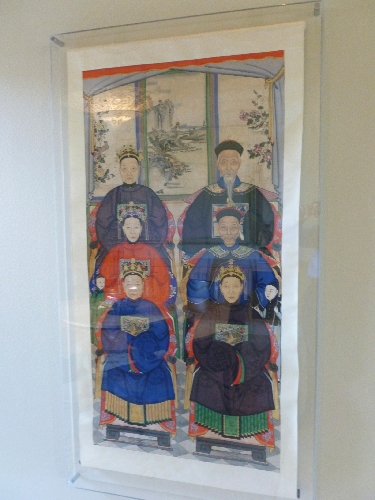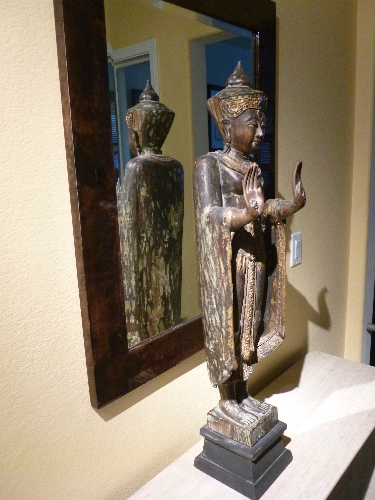Touch of the Orient adds interest to décor
San Francisco has a deep and long-lasting connection with its Asian community and boasts the largest Chinatown outside of the Chinese mainland as well as countless shops of all sizes selling myriad Asian accessories from the inexpensive to museum quality. On a recent business trip to the City by the Bay, which necessitated time spent at its wonderful design center, I was once again overwhelmed by the abundance and beauty of the Asian accessories so lovingly displayed in many of the showrooms. I found myself stopping to admire them and to think about their captivating appeal to people of so many diverse cultures.
In today's design world, it's seems that Asian accessories (as well as Asian-inspired furniture) proliferate. In fact, they've never been more popular, no doubt because they're timeless and possess the chameleonlike ability to harmonize with any design style from contemporary to traditional.
As I look around my own home and take stock of the accessories and art pieces displayed throughout, I realize that most are Asian and have been collected during the years that my wife and I have travelled for business or pleasure. To this day they continue to enrich our lives and bring great memories of how and where they were first acquired some in Bangkok or Chiang Mai, some in Hong Kong and others in Japan. They make wonderful complements to my own furniture designs, which were, in all likelihood, subliminally inspired by Asian design with its inherent emphasis on clean lines and strong geometric shapes and has continued to remain a foundation of my own design ethos.
Looking deeper into the broad appeal of everything Asian and why it remains so popular and pervasive in the design world, it may just go a step beyond its magical ability to be both modern and traditional as well as exotic - and all at the same time. There may actually be a psychological reason why people have been so enamored with collecting these treasures. It could be that Asian accessories from faraway lands speak to us not only on an aesthetic level, but on an emotional one as well.
Our Western love affair with all things Asian began as far back as the early 17th century, when fabulous lacquered furniture and blue and white porcelains were imported from China and Japan. It was then that trendsetting furniture designers started to incorporate Chinese style with European design. Maybe we, like our 17th century European ancestors, have a deep-seated longing to bring other cultures and artifacts into our everyday lives. And what great conversation it makes to talk about our travels and experiences when we're asked how we acquired these things.
For example, I don't know how many times I've enjoyed telling people about the large carved Tibetan figure that sits so proudly on a pedestal in my entry and how I first saw it all covered in dust and cobwebs on the floor of an antique shop in northern Thailand near the Myanmar border. It's a wonderful story. Getting excited about a favorite piece is the way it should be, and that's so easy when it's Asian.
Traditional Asian-themed accessories are often used to complete the overall look of a room and accomplish a cohesive style - no matter what the design may be. They're ubiquitous and easy to add to any home and can generally be found at reasonable prices at local retailers and online.
Most times they're made of natural materials in bolder colors and darker earth tones. These include items such as Buddha statues of all sizes, carved wooden ornaments and wall art, wall hangings, bamboo vases, rugs and blinds, rice paper lanterns, wrought iron, candlesticks, pottery and ceramics as well as opulent fabrics. These, along with decorative wallpapers (our breakfast room paper is Japanese, by the way) as well as Asian stencil art can create terrific vignettes while bringing a calm and Zen-like quality to your home.
Asian accessories often include a variety of plants like bamboo and bonsai trees, which can bring the life-affirming color green into a room. Also large Asian-influenced vases can be introduced as well as Chinese or Japanese art that can be displayed as a stand-alone art piece or in small groupings. Be sure to display a large piece in an area where it can be seen without too much distraction from any nearby accessories.
A cautionary note: It's important to balance any room in your home with a variety of Asian pieces and accessories. Using too many Asian designs on the wall, and too few complementary accessories elsewhere in the space will create an imbalance. It's important to remember that home décor of any style is at its best when care is given to balance and harmony and without presenting a cluttered effect.
Mixing and matching is always a good way to go for your accessories and always helps create a space that's more unique and personal. So don't think that you need to use only Asian accessories because family photos and other favorite ornaments will help to balance any décor with your own personal style.
Stephen Leon is a licensed interior designer and president of Soleil Design; he has been designing and manufacturing custom furniture and cabinetry for more than 25 years. He is president-elect of the Central California/Nevada Chapter of the American Society of Interior Designers and is a certified professional in green residential design. Questions can be sent to soleildesign@cox.net.



















